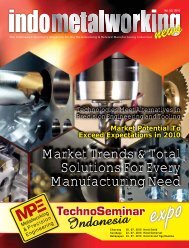High Speed Machining Precision Tooling - Indobiz.biz
High Speed Machining Precision Tooling - Indobiz.biz
High Speed Machining Precision Tooling - Indobiz.biz
Create successful ePaper yourself
Turn your PDF publications into a flip-book with our unique Google optimized e-Paper software.
ecipe for manufacturing indexable<br />
carbide inserts that deliver the desired<br />
performance characteristics is a function<br />
of the ratios among base components. In<br />
its simplest form, to increase an insert’s<br />
toughness (its resistance to fracture), the<br />
binder content-to-powder ratio is raised.<br />
To create a harder cutting material, the<br />
ratio is lowered, with more powder and<br />
less binder, which vmakes the cutter<br />
grades of carbide substrates refl ect<br />
a sliding scale between the extremes<br />
of toughness and hardness, which are<br />
matched to a given application.<br />
Mixing the binder and powder is a<br />
critical step in the manufacture of<br />
indexable insert tools. Like a “heat”<br />
in steel production, each batch of the<br />
recipe for a given base grade is carefully<br />
controlled for consistency.<br />
After mixing, the “batter” is pressed<br />
into a shape. The pressing process<br />
uses insert molds to impart the insert<br />
shape and some of the geometry, such<br />
as chipbreakers, onto the now “green”<br />
insert.<br />
In addition to the conventional pressing<br />
technology used by most insert<br />
producers, there is a successfully<br />
developed method of injection molding<br />
inserts as well. This gives the user the<br />
ability to mold complex inserts much<br />
closer to a fi nal shape and complete<br />
forms that would be almost impossible<br />
by conventional technology. In turn, it<br />
reduces the amount of grinding required<br />
to achieve a fi nished geometry and<br />
speeds the throughput.<br />
The details of this process are<br />
proprietary, but consist basically of<br />
adding a compound to the binder/<br />
powder mix so it can fl ow under pressure<br />
through gates into a closed mold cavity.<br />
This fl owable material is also extruded<br />
into tooling blanks that become the basis<br />
for some of the company’s solid carbide<br />
products. In the next manufacturing<br />
step, which is sintering, this additional<br />
compound vaporizes leaving no trace in<br />
the fi nal insert grade.<br />
Sintering is the last processing step<br />
before a green insert blank becomes<br />
the rugged carbide substrate that shops<br />
are familiar with. Using the cake-baking<br />
analogy, this step represents the oven.<br />
Under a vacuum at high temperature, the<br />
green insert is heated until the binder<br />
plasticizes, enabling it to fl ow around<br />
the grains of powder fi lling the voids.<br />
Upon cooling, the binder and grains are<br />
chemically and physically linked into a<br />
uniform matrix.<br />
On The Shop Floor<br />
Out of the oven, the inserts are ready<br />
to be machined to their fi nal shapes,<br />
geometry and precision. The shop fl oor<br />
refl ects this rationalization concept.<br />
The grinding department is arranged<br />
in rows of autonomous cells. Four of<br />
these cells are operated by one person.<br />
Each cell is built around a DMG milling<br />
machine converted to grind inserts. In<br />
the machine spindle, an arbor is used<br />
to hold various superabrasive wheels<br />
and brushes allowing all of the grinding<br />
operations to be performed in sequence<br />
without changing wheels.<br />
An automated load/unload system shall<br />
be designed and feeds the machine<br />
tools. As a fi nished insert is removed<br />
from the work zone, it passes through a<br />
laser gaging system that checks critical<br />
dimensions. This cellular concept is<br />
duplicated at every manufacturing<br />
company nowadays.<br />
While the cells are not dedicated to a<br />
specifi c cutting tool product, they are<br />
tooled to accommodate like families<br />
of inserts. It should have several types<br />
of cells to accommodate various insert<br />
parameters. The production schedule is<br />
made up to run similar jobs sequentially,<br />
which simplifi es change-over from one<br />
insert to another. Generally, only the<br />
material handling devices and gaging<br />
units need to be physically adjusted.<br />
To do own insert coating it shall use a<br />
PVD (physical vapor deposit) system.<br />
Inserts to be coated are fi rst cleaned in<br />
an automated (no-touch) batch washing<br />
system. The clean inserts are assembled<br />
into racks for placement in the coating<br />
chamber. Three different coatings can<br />
be used individually or layered.<br />
1. <strong>Precision</strong> 1 : To expedite the grinding process,<br />
an arbor with various wheels and brushes is used<br />
in the grinding cell. The arbor is supported by a<br />
dual contact V-flange connector<br />
2. <strong>Precision</strong> 2: In addition to sintering its own<br />
inserts, the company also uses a PVD process to<br />
coat various insert grades. The racks on the left<br />
are shown prior to coating, and the racks on the<br />
right have been processed.<br />
3. <strong>Precision</strong> 3: Insert grinding is arranged in<br />
cells. These are comprised of converted milling<br />
machines set up to grind inserts. Load/unload and<br />
inspection is automated, enabling one operator to<br />
oversee four cells<br />
indometalworking news Vol. 2 / 2008 13




